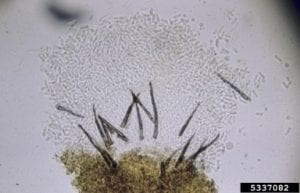Nathan Kleczewski, Extension Specialist – Plant Pathology; nkleczew@udel.edu
Now is the time to be scouting corn for development of common, potentially problematic diseases.
Anthracnose
Look for irregular, “candle flame” lesions on the lower leaves of corn seedlings (Figure 1). Close inspection of these lesions with a hand lens may reveal dark spines resembling eyelashes (Figure 2). These structures, called setae, are a pretty good diagnostic feature of corn anthracnose caused by the fungus Colletotrichum graminicola. This disease is residue borne and can cause a leaf blight during early phases of growth (around V5-8). Conditions that favor the disease include corn after corn production, no till or minimal till production, and irrigation. Early foliar symptoms are not the direct cause of anthracnose stalk rot that can occur later in the season. However, if you have anthracnose in seedlings you should take note and scout for anthracnose stalk rot later in the growing season. The stalk rot phase is distinguished by black shiny lesions on the surface of the stalks. For more information on Anthracnose of corn, refer to my factsheet: http://extension.udel.edu/factsheet/anthracnose-leaf-blight-and-stalk-rot-of-corn/
Figure 1. Symptoms of anthracnose on the lower leaves of corn. Note the irregular lesions with yellow halos. Inspection of lesions should yield black spines or setae (see Figure 2).
Figure 2. Close up of Colletotrichum fruiting body with characteristic “eyelash” setae and spores. Photo by C. Drake. Obtained from Bugwood image archive at www.ipmimages.org.
Gray Leaf Spot
Another important disease you start scouting for soon, particularly if you are irrigating and planting corn after corn, is Gray Leaf Spot. The disease first appears as small, necrotic spots or flecks. Spots usually expand to become rectangular lesions, about 1/8” wide by up to 2″- 3″long and gray to brown in appearance (Figure 3). When held to the light, lesions are opaque. Conditions favorable for disease include wet weather and warm (70-80°F) temperatures, and high amounts of corn residue in the field. The disease starts on lower leaves and will move up the plant as long as conditions remain favorable for infection. Additional information on Gray Leaf Spot can be found in the following factsheet: http://extension.udel.edu/factsheet/gray-leaf-spot-on-corn/
Figure 3. Mature lesions of Gray leaf spot on corn. Note rectangular appearance.
Rust
On another note, we have seen rusts start up early in corn early in the South this season, and recent tropical storms are likely to increase disease spread. Southern rust has appeared late in fields over the last two seasons but can be quite damaging if it arrives before grain fill, as the pathogen can reproduce in as little as 5 days. Southern rust differs from common rust in many aspects (Table 1).
Table 1. A comparison of Southern rust and common rust in corn.
| Feature | Southern Rust | Common Rust |
| Pustule color | Light orange to brown | Brown/red |
| Location on leaf surface | Upper leaf surface (mostly) | Upper and lower leaf surfaces |
| Presentation on leaf | Patches | Scattered |
| Tissues affected | Leaves and husks | Leaves only |
| Temperature optima | 77-82⁰F | 61-77⁰F |
Figure 4. A visual comparison of Southern rust pustules and common rust pustules.




